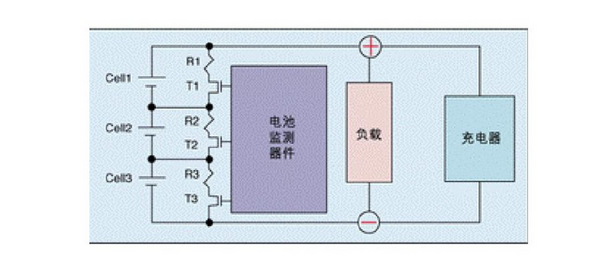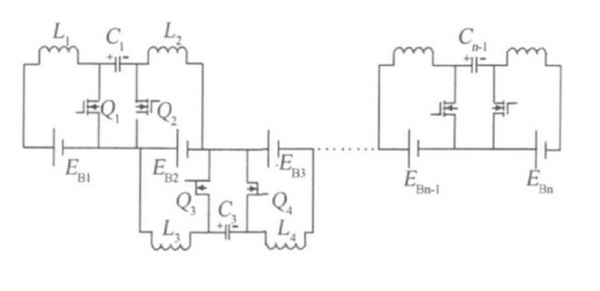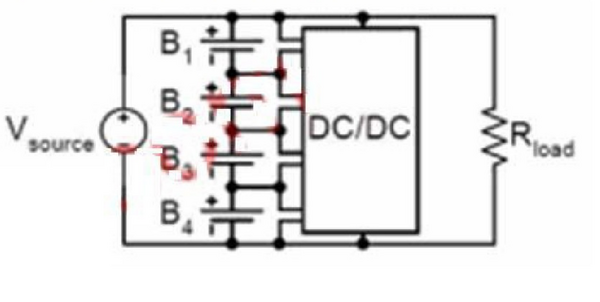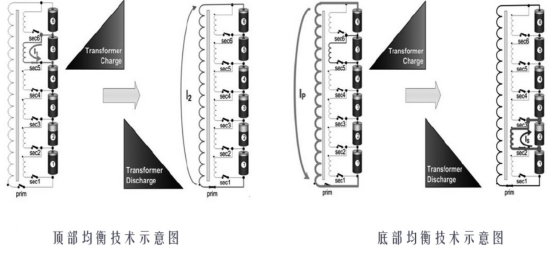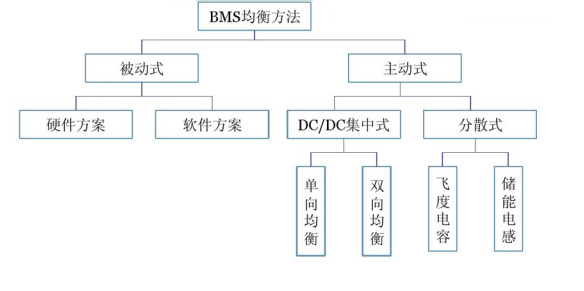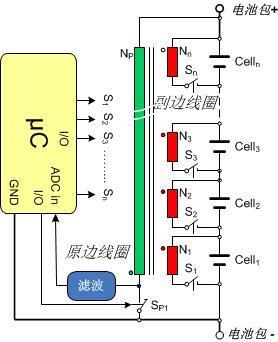Introduction to BMS cell balancing
The battery management system (BMS) is mainly to improve the utilization rate of the battery, prevent the battery from overcharging and overdischarging, extend the battery life, and monitor the battery status. Its role is to exchange information with the vehicle control computer in a timely manner through CAN communication on various parameters such as voltage, current, temperature, capacity, battery SOC charge status, battery and vehicle body insulation status, etc. The energy is exerted to the extreme, so that the driver can grasp the working status of the battery at any time to ensure the safety of the battery. The functions of BMS include battery working status monitoring, charge and discharge management, and cell-cell balancing, among which balancing is the core of battery management. Single lithium batteries are generally used in lithium battery packs. During the use of the lithium battery pack, due to the difference between the single battery itself and the external environment, the voltages of the single battery cells of the lithium battery pack are actually unbalanced. One of the single lithium batteries is overcharged or overdischarged, which greatly reduces the service life of the lithium battery. Causes of inconsistency: In the manufacturing process, due to process problems and uneven materials, there are smile differences in battery plate thickness, microporosity, and activation degree of active materials. The internal structure and material of this battery are not Complete consistency will make it impossible for the same batch of batteries of the same model, such as capacity, internal resistance and voltage, to be completely consistent; When used in a vehicle, due to the influence of the temperature, ventilation conditions, self-discharge level, electrolyte density and other differences of the batteries in the battery pack, the battery voltage is increased to a certain extent due to the influence of differences in electrolyte density , Internal resistance and capacity are inconsistent. Well, the purpose of BMS balancing is to extend the life of the battery pack. Introduction to equilibrium methods 1. Passive equilibrium Passive equalization is divided into hardware and software solutions 1. Introduction of passive hardware solutions The charging terminal is balanced, the balancing current is 55mA, there is no pressure difference comparison, and the balancing is started after the single battery reaches a certain point. For example, 1oS ternary battery, the single channel discharge after the monomer reaches 4.19V. 2. Passive software solution balance Starting equilibrium conditions: there is the highest voltage value of the monomer, the highest and lowest pressure difference of the monomer, and the balance of contrast and selectivity. For example, in a 1oS battery, first collect the cell voltage and calculate the maximum and minimum pressure difference. When the pressure difference is greater than 50mV and the cell is greater than 3.8V, the equalization is started. At this time, if the cell is greater than 3.8V, the equalization is started. It is that the monomer is greater than 3.8V and 50mV higher than the minimum of the monomer, that is, the single channel equalization is turned on (the parallel resistance discharge is turned on). 2. Active Balance Active lossless equilibrium is divided into centralized and decentralized according to the flow of energy The centralized equalization method is to obtain energy from the entire group of batteries, and then supplement the power of the battery with less energy through the electric energy conversion device; The decentralized equalization method is that there is an energy storage link between adjacent batteries. This energy storage link can be an inductor or a capacitor, so that energy can flow between adjacent batteries, and batteries with more energy can Transfer energy to a battery with less energy. The ultimate goal of these two methods can balance the entire battery. 1. Lossless equilibrium-decentralized The decentralized type is currently divided into: capacitive type (fit capacitance method) and energy storage inductive type 1.1 Capacitive type: That is, by switching the capacitor switch, the charge is transferred from the battery with a high voltage to the battery with a low voltage to achieve equilibrium. It requires multiple transmissions to achieve equilibrium, and the voltage difference between the two batteries is small. Each two batteries form an equalization unit. As shown in the figure above, batteries EB1 and EB2 form the first equalization unit. Energy storage capacitor C1; energy storage inductances L1 and L2; switches Q1 and Q2 form an equalization circuit. When EB1 and EB2 are unbalanced, the equalization circuit alternately switches under the drive of two square waves with opposite phases. The energy exchange channel formed by the energy storage element successively transfers the charge of the battery with high voltage to the battery with low voltage. Until the two batteries are balanced. 1.2 Symmetric distributed energy transfer of energy storage inductors The charge equalization circuit is shown in the figure. The battery pack is composed of multiple single cells connected in series, and the charging power source is represented by a constant current source of size Ic. Each series battery is connected with a balancing circuit module Mn. Each balancing module is composed of an energy storage inductor, a switching device and a diode, and is symmetrically distributed on both sides of the battery pack. When the switching device Sn in the equalization module Mn is turned on, the battery Bn charges the inductor Ln to store energy, and the inductor current rises linearly. When Sn is turned off, the energy in the inductor Ln continues to flow through the diode to other batteries. The energy storage inductance of the upstream battery flows freely to the downstream battery through the diode, and the energy storage inductance of the downstream battery flows freely to the upstream battery through the diode. The switching devices in each equalization circuit can be turned on at the same time, and its on-off is controlled by the PWM pulse output by the controller, adjusting the size of the PWM duty cycle, which can effectively adjust the energy transfer speed. 2. Lossless equalization --- centralized One-way and two-way equalization according to the flow of energy processed by the equalizer The bidirectional type uses a bidirectional converter, and the input and output directions are dynamically adjusted. In comparison, the two-way type is more advantageous. Based on the consideration of balancing efficiency, the one-way type equalizer uses a converter from the high voltage of the unit to the low voltage of the unit. Suitable for charging balance. 2.1 Centralized one-way equilibrium 2.2 Centralized two-way equalization New active balancing scheme based on transformer architecture The scheme uses a flyback transformer as the core, through the conversion of magnetic field and electric field, to achieve the bidirectional transmission of energy between a single battery unit and the entire battery pack. The specific process of battery charge and discharge balance can be described as "robbing the rich and helping the poor". Second, the advantages and disadvantages of each balance program comparison Passive equilibrium Advantages: simple circuit structure and low cost Disadvantages: only charge equalization. At the same time, in the process of charging equalization, the excess energy is released as heat, which makes the entire system low in efficiency and high in power consumption, with a balanced current of 50mA BMS application: electric bicycle, electric motorcycle Fit capacitor solution Advantages: low cost, simple structure, high active energy utilization Disadvantages: The equilibrium efficiency is limited, and the capacitor is used as a carrier for energy transfer. This solution can realize the direct transfer of energy between any two cells of the battery pack. Since the equalization current is limited by the difference between the capacitor voltage and the voltage of the cells in the battery pack, as the equalization process progresses, the equalization speed will become slower and slower, and the equalization current is about 300mA. Energy storage inductor solution: Advantages: Active energy utilization rate is high, the balance effect is greater than the capacitor scheme, and the mass balance current is 5A. Disadvantages: energy can only be transferred between two adjacent sections High cost and complicated structure DC / DC unidirectional equilibrium: The equilibrium performance is limited, and the current for mass production can reach 1A. DC / DC bidirectional equalization: ideal equalization effect, high cost, complex structure, suitable for large power batteries or batteries of energy storage stations, and the current for mass production can reach 5A. Equalization method selection The importance of balance to the power lithium battery pack will not be repeated. The lithium battery pack without balance is like an engine that cannot be maintained. The BMS without balance function is just a data collector, which is difficult to be called a management system. . Both active equalization and passive equalization are designed to eliminate inconsistencies in battery packs, but the implementation principles of the two are diametrically opposed. Because some people define the equilibrium that is actively initiated by the BMS based on the algorithm as an active equilibrium. To avoid ambiguity, the equilibrium that uses energy dissipated by resistance is called passive equilibrium, and the equilibrium that is achieved by energy transfer is called active equilibrium. . Passive equalization occurs before active equalization because of its simple circuit and low cost. It is still widely used today. The principle is that according to the battery's power and voltage are positively correlated, according to the single-string battery voltage data, the high-voltage battery energy is discharged through the resistor to maintain the same state as the low-voltage battery's power, and the highest voltage is used as a criterion, such as ternary The lithium battery has a maximum voltage of 4.2V, and any discharge exceeding 4.2V will start the discharge equalization. Because the BMS concept and products were first proposed by foreign countries, foreign semiconductor manufacturers first designed dedicated ICs, which initially only detected voltage and temperature. Later, after the concept of equilibrium was proposed, the method of resistance discharge was adopted and this function was added to the IC (Because this discharge control function is easy to be integrated into the chip), TI \ MAXIM \ LINER, which is widely used now, has such chips in production, some of them are driven by the switch, and some even try to integrate the switch into the chip. In the chip. From the principle and schematic diagram of passive equalization, we can see that if the battery pack is compared to a wooden barrel, the battery connected in series is the board that constitutes the wooden barrel, the battery with low power is the short board, and the battery with high power is the long board, passive balancing is done The job is to "cut the length without making up the short". The energy in a battery with a high amount of electricity is dissipated as heat, and the efficiency of using electric energy is low. Not only that, because the conversion of electrical energy into heat dissipation brings a dilemma. This is if the equilibrium current is large, the heat is more, and finally how to dissipate heat becomes a problem; if the equilibrium current is small, then in the large capacity battery pack, the power In the case of large differences, the efficiency of the cell balance is very low. It takes a long time to reach the balance. There is a feeling of itching in the application. Weighing the pros and cons, so the current of passive equalization is generally at the level of 100 milliamps (100mA). Because of the limitations of passive equilibrium, the concept of active equilibrium has been proposed and developed. Active equalization is to transfer the energy from the high-energy battery to the low-energy battery, which is equivalent to "cutting the length of the board". Because unlike passive equilibrium, which only has "cutting", the industry has fully exerted its respective advantages and imagination on the issue of how to "compensate", and the scheme of active balancing can be described as colorful. In addition to the Fit capacitor solution (because of the low number of strings applicable, the transfer has limitations and failed to become the mainstream), there are also transformer solutions, and there are various topologies in the transformer solution. Semiconductor manufacturers have also designed battery-specific DCDC conversion chips, named as active equalization control chips, to market, apparently do not want to miss this bus. The benefits of active equalization are obvious: high efficiency, energy is transferred, the loss is only the transformer coil loss, and the proportion is small; the equalization current can be designed to be large, reaching a few amps or even 10A level, and the balance is effective quickly. Despite these benefits, active balancing also brings new problems. The first is the complex structure, especially the transformer solution. How to design the switch matrix required by dozens or even hundreds of batteries and how to control the drive are all headaches, so this is why the active equalization function cannot be fully integrated into the dedicated IC so far. Semiconductor manufacturers have always wanted Can make a big unified chip, but it is really weak on BMS. The same is true for BMS manufacturers. In terms of active equalization circuit structure, few manufacturers' designs can be refreshing and applauding. Secondly, there is the cost problem. Complex structures will inevitably bring complex circuits. The increase in cost and failure rate is inevitable. The price of BMS with active balancing function will be much higher than that of passive balancing. This also limits the active balancing of BMS. Promotion. Because the two equalization functions have their own advantages and disadvantages, the original active equalization function can replace the passive equalization function, but because the structure is complicated and the cost is high, and the failure rate will also be high after the structure is complex, it is in a state of being stuck with passive equilibrium. This kind of equilibrium is better debated. Tesla's BMS equalization function (passive equalization, see the discharge resistance in the Cell balancing circuit in the figure below) is often demonstrated to prove that passive equalization is stronger than active equalization. In fact, this proves that any technical choice must be applicable to the overall conditions. Tesla's battery is a special 18650 lithium battery provided by Panasonic. The consistency itself is very good, and the difference in consistency is limited during the lifetime. Passive balancing is enough. Unlike our country, where battery raw materials to production processes need to be improved, the degree of dispersion of battery consistency is still relatively large, and active balancing will be more suitable for power lithium battery applications. Passive equalization is suitable for small capacity and low string number lithium battery pack applications, and active equalization is suitable for high string number and large capacity power lithium battery pack applications. For BMS, in addition to the very important balancing function, the balancing strategy behind it is more important. When the consistency difference of the battery cells is within a certain range, the battery's charge and voltage are positively correlated; but when the consistency of the battery is far away, that is, when the battery is in a damaged state, the correlation between charge and voltage is not so strong However, the basis of the equilibrium at this time cannot be judged solely by the data of voltage. If you do not realize that the battery is damaged below the critical state, it will still harm the battery according to the voltage balance, especially the active balance. The damage caused by the large current will be greater than the passive balance. Both active and passive equilibrium have their application value. Equilibrium technology is not the same as God. The overall design of BMS and the matching with the whole vehicle is the key. At the same time, the advantages and disadvantages of the two BMS equilibrium methods are obvious, and the controversy is mainly the question of which method is more reasonable at home and abroad. But it still depends on the characteristics of the battery. In the case of strong cell consistency, a small-capacity battery pack is more suitable for passive balancing. If the consistency of the large-capacity power battery is general, the use of active balancing can better adapt to the use requirements. Green Screen,Key Chrome Green Screen,Portable Floor Green Screen,Chroma Key Green Screen Background Dongguan Aoxing Audio Visual Equipment CO.,Ltd , https://www.aoxing-alr.com
